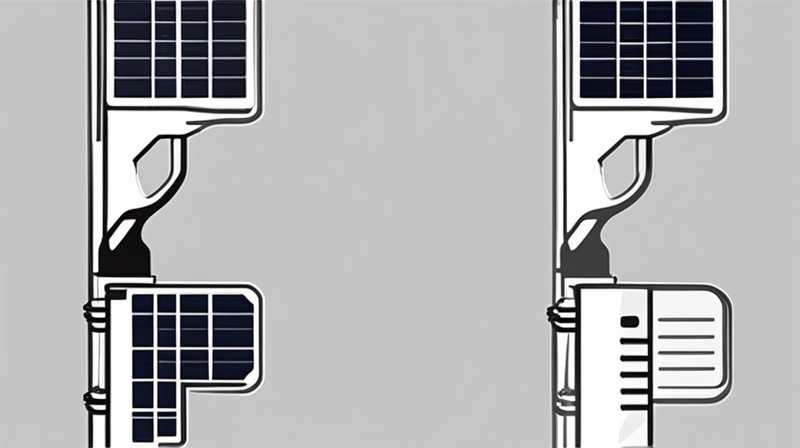
When evaluating the brightness of a 110w solar street light, several key factors come into play: 1. Luminous efficacy, 2. LED technology, 3. Beam angle, 4. Overall design and application. The brightness level can be quite substantial, providing adequate illumination for typical street lighting needs.
1. LUMINOUS EFFICACY
To comprehend the brightness of a solar street light rated at 110 watts, understanding luminous efficacy is essential. Luminous efficacy refers to how well a light source converts electrical energy into visible light, measured in lumens per watt (lm/W). A high luminous efficacy indicates superior performance, with modern LED technologies commonly achieving between 80 to over 120 lm/W. Therefore, a 110w solar street light with 100 lm/W efficacy would generate about 11,000 lumens, presenting sufficient brightness for various settings, including streets, parking lots, and pathways.
Moreover, the efficiency of solar panels must not be overlooked. Solar panels, converting sunlight into electrical energy to power the light fixture, are pivotal in determining overall output and performance. Advanced solar technology often allows greater energy capture, ensuring that the light remains bright through varying weather conditions, a critical factor that influences end-user experience.
2. LED TECHNOLOGY
The type of LED utilized in a solar street light is paramount in defining its brightness and overall effectiveness. High-quality LEDs, such as those made from materials like gallium nitride, exhibit excellent performance characteristics, including higher lumen output and longer lifespan. These elements contribute significantly to both the brightness and longevity of the fixture.
In addition, the binning process of LEDs—where manufacturers group similar color and output products—plays an integral role. Ensuring uniformity across fixtures not only enhances illumination but also reduces light pollution and creates a more aesthetically pleasing environment.
3. BEAM ANGLE
The beam angle of a solar street light significantly influences how light is distributed across an area. A narrower beam focuses light in a concentrated manner, ideal for illuminating specific spots, while a wider beam disperses light over a larger area. For a 110w solar street light, determining the intended application helps guide the selection of the optimal beam angle.
When strategically placed, the beam angle enhances pedestrian safety, reduces crime rates, and improves visibility at night. Consequently, this feature impacts public perception and acceptance of such lighting solutions in urban and rural settings.
4. OVERALL DESIGN AND APPLICATION
Ultimately, the design of a solar street light encompasses various features beyond its wattage and luminous performance. Factors such as pole height, mounting structures, and surrounding infrastructure must be considered. A well-designed lighting fixture, combined with the placement of reflectors or diffusers, can serve to amplify brightness and ensure uniform light distribution throughout the selected area.
Application contexts vary widely, from residential neighborhoods to commercial zones. Each setting requires a tailored approach to maximize brightness and effectiveness. Planning for pedestrian zones necessitates different lighting configurations and intensities than those for vehicular roadways, emphasizing the necessity for detailed analysis prior to implementation.
FREQUENTLY ASKED QUESTIONS
WHAT IS THE LUMEN OUTPUT OF A 110W SOLAR STREET LIGHT?
The lumen output of a 110w solar street light can significantly vary based on the technologies employed. Typically, most modern LED street lights provide around 100 lumens per watt, leading to an estimated lumen output of approximately 11,000 lumens. This measurement holds crucial importance, as it determines how well the light can illuminate its designated area. A high lumen rating means that a light can cover more ground and offer increased safety for pedestrians and drivers alike. However, it is vital to consider the solar panel’s efficiency and the light’s luminous efficacy, which may slightly affect practical output based on environmental conditions, such as cloudy weather or obstructions that hinder sunlight exposure.
HOW DOES WEATHER AFFECT THE PERFORMANCE OF SOLAR STREET LIGHTS?
Weather conditions can substantially impact solar street lights’ performance, particularly with regard to their brightness and efficiency. Rainy or overcast days may reduce sunlight absorption by the solar panels, thereby limiting the stored energy for nighttime illumination. Modern advancements, however, often incorporate high-capacity batteries that allow solar lights to function effectively, even with minimal sunlight. Additionally, some solar street lights feature integrated sensors that adjust brightness based on detected ambient light levels, optimizing energy consumption and preventing inadequate lighting during especially dark or inclement weather. Users should also take local climate patterns into account when assessing the suitability of solar-powered lighting in their area, ensuring adequate performance year-round.
WHAT FACTORS SHOULD BE CONSIDERED WHEN INSTALLING SOLAR STREET LIGHTS?
When deciding to install solar street lights, key factors should be thoroughly examined to ensure effectiveness and satisfaction. First, assess the location to determine sunlight exposure throughout the day, as trees, buildings, or other structures could obstruct solar panel efficiency. Next, consider the lumen output required for safety and visibility in the intended area. Other elements include the necessary pole height, mounting options, and local regulations regarding street lighting. Furthermore, examine the overall design, including aesthetics and operational features, such as motion sensors or timers, to facilitate energy efficiency. Planning not only ensures adequate brightness levels but also fosters community acceptance and enhances the public spaces where these lights will be installed.
In summary, solar street lights rated at 110 watts provide a substantial level of luminosity, catering to various applications while considering essential elements such as luminous efficacy, LED technology, beam angle, and overall design. A sophisticated understanding of these factors sheds light on the advantages of solar-powered lighting solutions, particularly in promoting sustainability and safety in urban planning. As utility costs continue to rise and environmental concerns mount, the role of solar street lights is poised to grow even more crucial, effectively impacting communities by enhancing lighting while minimizing carbon footprints.
Original article by NenPower, If reposted, please credit the source: https://nenpower.com/blog/how-bright-is-a-110w-solar-street-light/


